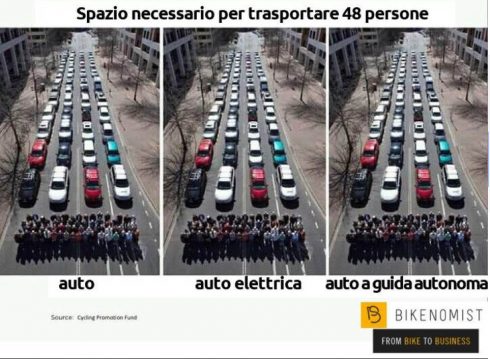More evidence that the anti-car crowd can’t think its way out of a paper bag. Even when they could make a much better case for themselves.
The text, in Italian, reads “space necessary to transport 48 persons: auto, electric car, robotic car.”
Only, the cars aren’t transporting anyone. They are all parked. They would take up much more space if in motion, just to have a safe following distance. The robotic cars would take up somewhat less space, due to their quicker reaction time for braking, but still much more than shown in the picture.
Twice before on this blog, I’ve shown similar posters making similar claims, and each time, they have shown parked vehicles.


It’s instructive to point out following space. The posters would be more accurate if labeled as “the space to park vehicle.” But I think you are being overly critical. Just how can one depict following space, which varies with speed, in a static poster? The medium itself poses some constraints.
It would not be difficult to park the cars further apart to illustrate the following distance needed at the posted speed limit for the city street on which they’re posed. As John points out, this would greatly increase the space the cars take up and thus illustrate their point even better.
You can see them as stopped at a light or in a traffic jam.
Showing a car in full flow may not be the most effective anti-car visual. That’s what car commercials do.
That comment illustrates the difference between factual information and propaganda — from both sides: car commercials, and the anti-car posters. In both cases, the goal is to influence people without regard for a strightforward exposition of facts. The fakery in the car commercials promotes car use and the fakery of showing parked cars in an anti-car message also promotes car use by understating the anti-car message.
Traffic jams are actually an undisputed fact.
Another fact is a car occupancy; none of the vehicles shown is a one-seat F1 race car. I’m sure occupancy studies exist and the numbers may be different for different regions; personally, I’m alone in my car only a small fraction of the time. That’s another fact. However, the picture shows 48 cars which is not perceived as ‘fakery’.
There are facts and there is selection bias (which is also a fact).
1) with the standard 5 seaters you can fit 48 people in 10 cars (even less if you have minivans). That’s just basic math.
2) with bikes you also need the following distance. In addition you’ll also need spacing on the sides
Both of your statements are true, but: